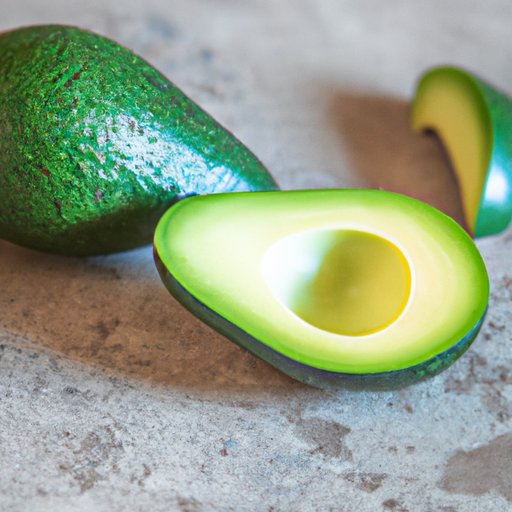
How to Ripen Avocados: Tips and Tricks
There’s nothing quite like a ripe avocado: rich, creamy, and full of flavor. But the process of ripening avocados can be a frustrating one, with fruit often staying hard and unripe long after we want to eat them. In this article, we’ll explore the ins and outs of avocado ripening, offering tips and insights to help you achieve perfectly ripe fruit every time.
An Overview of Avocado Ripening
Many factors affect the ripening times of avocados. These include the variety of avocado, the temperature and humidity of the storage environment, and even the fruit’s maturity at the time of harvest. In general, avocados ripen best at temperatures between 65 and 75 degrees Fahrenheit and in environments with relatively high humidity (around 90%).
When selecting avocados to ripen, it’s best to choose those with a slightly softer texture and dark green to black skins. It’s also important to avoid any fruit with visible bruises or damaged areas, which can cause the avocado to spoil more quickly over time.
Techniques for Ripening Avocados Faster
There are several tried-and-true methods for ripening avocados more quickly. One of the most effective techniques involves placing the fruit in a paper bag with an apple or banana. The fruits release ethylene gas, which accelerates the ripening process.
Another approach is to place avocados in a sunny location. The warmth and light can speed up the natural ripening process, although it’s essential to monitor the fruit closely to avoid over-ripening or spoilage.
Finally, you can try wrapping avocados individually in foil and then baking them in the oven at 200 degrees Fahrenheit for 10-15 minutes. This can soften the avocado’s flesh, making it easier to eat and enjoy.
The Science of Avocado Ripening
Avocado ripening is a fascinating process that involves both physical and chemical changes within the fruit. As avocados mature, enzymes within the fruit break down complex molecules into simpler ones that contribute to the characteristic flavor and texture of a ripe avocado.
Specifically, the enzymes known as lipases break down certain fatty acids in the avocado, which creates free fatty acids that contribute to the fruit’s flavor and aroma. Meanwhile, the enzyme polygalacturonase softens the flesh of the avocado by breaking down the cell walls that give the fruit its structure and firmness.
To harness these processes for optimal ripeness, it’s essential to understand how temperature and humidity affect avocado ripening. As mentioned earlier, avocados ripen best at temperatures between 65 and 75 degrees Fahrenheit and in a relatively high-humidity environment. Storing avocados in the refrigerator can be detrimental to the ripening process, as temperatures below 40 degrees can cause the fruit to turn black and spoil relatively quickly.
Creative Recipes for Dealing with Hard Avocados
What should you do when you have a batch of underripe avocados that you can’t wait to enjoy? While it might be tempting to simply toss them out, there are plenty of creative recipes that make use of firm, unripe fruit.
For example, you can experiment with making “guacamole” using unripe avocados and Greek yogurt or sour cream. This recipe offers a tangy, creamy flavor that pairs well with chips or veggies.
You can also use unripe avocado in smoothies to add a boost of healthy fat and creaminess. Simply blend an underripe avocado with other fruits like banana, berries, and pineapple for a delicious and nutrient-rich treat.
The Best (and Worst) Ways to Store Avocados
When it comes to storing avocados, there are several options – but some are better than others. In general, it’s best to store avocados at room temperature until they reach the desired level of ripeness. Once ripe, you can either eat the fruit or refrigerate it to help preserve it for longer.
However, it’s essential to avoid plastic bags or tightly sealed containers, as these can trap moisture and cause the fruit to rot. Instead, store avocados in a loosely sealed paper bag or on a plate with a light towel draped over them to absorb any excess moisture.
How to Tell When Your Avocados are Perfectly Ripe
Determining when an avocado is perfectly ripe requires a bit of intuition and some physical examination. One good sign is the color of the avocado’s skin: if it’s bright green, the fruit is likely unripe, while a dark green to black hue indicates that it’s ready to eat.
You can also gently press the stem of the avocado – if it feels soft and gives slightly, the fruit is ripe. Conversely, if the stem feels hard and unyielding, the avocado is likely underripe. It’s also important to note that some varieties of avocados may ripen more slowly than others, so it’s often best to experiment and see what works best for you.
Conclusion
Ripening avocados can be a challenging process, but with these tips and tricks, you can enjoy perfectly ripe fruit every time. Remember to choose avocados carefully, experiment with different ripening techniques, and store your fruit in a cool, dry place until it’s ready to eat. With these insights, you’ll be an avocado-ripening pro in no time.




